Prognostic Value of Estimated Glucose Disposal Rate and Systemic Immune-Inflammation Index in Non-Diabetic Patients Undergoing PCI for Chronic Total Occlusion
Abstract
:1. Introduction
2. Methods
2.1. Study Population and Follow-Up
2.2. Data Collection
2.3. Statistical Analysis
3. Results
3.1. Baseline Characteristics
3.2. Impact of eGDR and SII on CTO PCI Patients
3.3. Impact of Combined eGDR and SII on Prognosis in CTO PCI
3.4. Subgroup Analysis
3.5. Mediation Analyses
4. Discussion
5. Limitations
6. Conclusions
Author Contributions
Funding
Institutional Review Board Statement
Informed Consent Statement
Data Availability Statement
Acknowledgments
Conflicts of Interest
References
- Azzalini, L.; Karmpaliotis, D.; Santiago, R.; Mashayekhi, K.; Di Mario, C.; Rinfret, S.; Nicholson, W.J.; Carlino, M.; Yamane, M.; Tsuchikane, E. Contemporary Issues in Chronic Total Occlusion Percutaneous Coronary Intervention. JACC Cardiovasc. Interv. 2022, 15, 1–21. [Google Scholar] [CrossRef] [PubMed]
- Ybarra, L.F.; Rinfret, S.; Brilakis, E.S.; Karmpaliotis, D.; Azzalini, L.; Grantham, J.A.; Kandzari, D.E.; Mashayekhi, K.; Spratt, J.C.; Wijeysundera, H.C.; et al. Definitions and Clinical Trial Design Principles for Coronary Artery Chronic Total Occlusion Therapies: CTO-ARC Consensus Recommendations. Circulation 2021, 143, 479–500. [Google Scholar] [CrossRef] [PubMed]
- Tajstra, M.; Pyka, Ł.; Gorol, J.; Pres, D.; Gierlotka, M.; Gadula-Gacek, E.; Gąsior, M. Impact of Chronic Total Occlusion of the Coronary Artery on 340 Long-Term Prognosis in Patients with Ischemic Systolic Heart Failure: Insights from the 341 COMMIT-HF Registry. JACC Cardiovasc. Interv. 2016, 9, 1790–1797. [Google Scholar] [CrossRef] [PubMed]
- Brilakis, E.S.; Mashayekhi, K.; Burke, M.N. How DECISION-CTO Can Help Guide the Decision to Perform Chronic Total Occlusion Percutaneous Coronary Intervention. Circulation 2019, 139, 1684–1687. [Google Scholar] [CrossRef] [PubMed]
- Zhang, Z.; Zhao, L.; Lu, Y.; Meng, X.; Zhou, X. Association between non-insulin-based insulin resistance indices and cardiovascular events in patients undergoing percutaneous coronary intervention: A retrospective study. Cardiovasc. Diabetol. 2023, 22, 161. [Google Scholar] [CrossRef]
- Jin, A.; Wang, S.; Li, J.; Wang, M.; Lin, J.; Li, H.; Meng, X.; Wang, Y.; Pan, Y. Mediation of systemic inflammation on insulin resistance and prognosis of nondiabetic patients with ischemic stroke. Stroke 2023, 54, 759–769. [Google Scholar] [CrossRef] [PubMed]
- Ye, Z.; Xu, Y.; Tang, L.; Wu, M.; Wu, B.; Zhu, T.; Wang, J. Predicting long-term prognosis after percutaneous coronary intervention in patients with new onset ST-elevation myocardial infarction: Development and external validation of a nomogram model. Cardiovasc. Diabetol. 2023, 22, 87. [Google Scholar] [CrossRef] [PubMed]
- Bornfeldt, K.E.; Tabas, I. Insulin resistance, hyperglycemia, and atherosclerosis. Cell Metab. 2011, 14, 575–585. [Google Scholar] [CrossRef]
- Jia, G.; Whaley-Connell, A.; Sowers, J.R. Diabetic cardiomyopathy: A hyperglycaemia- and insulin-resistance-induced heart disease. Diabetologia 2018, 61, 21–28. [Google Scholar] [CrossRef]
- Bonora, E.; Targher, G.; Alberiche, M.; Bonadonna, R.C.; Saggiani, F.; Zenere, M.B.; Muggeo, M. Homeostasis model assessment closely mirrors the glucose clamp technique in the assessment of insulin sensitivity: Studies in subjects with various degrees of glucose tolerance and insulin sensitivity. Diabetes Care 2000, 23, 57–63. [Google Scholar] [CrossRef]
- Ren, X.; Jiang, M.; Han, L.; Zheng, X. Estimated glucose disposal rate and risk of cardiovascular disease: Evidence from the China health and retirement longitudinal study. BMC Geriatr. 2022, 22, 968. [Google Scholar] [CrossRef]
- Açar, G.; Kalkan, M.E.; Avci, A.; Alizade, E.; Tabakci, M.M.; Toprak, C.; Özkan, B.; Alici, G.; Esen, A.M. The Relation of Platelet-lymphocyte Ratio and Coronary Collateral Circulation in Patients with Stable Angina Pectoris and Chronic Total Occlusion. Clin. Appl. Thromb. Hemost. 2015, 21, 462–468. [Google Scholar] [CrossRef] [PubMed]
- Perera, D.; Ryan, M.; Morgan, H.P.; Greenwood, J.P.; Petrie, M.C.; Dodd, M.; Das, P. Viability and Outcomes with Revascularization or Medical Therapy in Ischemic Ventricular Dysfunction: A Prespecified Secondary Analysis of the REVIVED-BCIS2 Trial. JAMA Cardiol. 2023, 8, e233803. [Google Scholar] [CrossRef] [PubMed]
- American Diabetes Association. Diabetes American 2 Classification and diagnosis of diabetes: Standards of medical care in diabetes-2018. Diabetes Care 2018, 41, 27. [Google Scholar]
- Chang, Y.S.; Li, Y.H.; Lee, I.T. A synergistic effect of variability in estimated glomerular filtration rate with chronic kidney disease on all-cause mortality prediction in patients with type 2 diabetes: A retrospective cohort study. Cardiovasc. Diabetol. 2021, 20, 209. [Google Scholar] [CrossRef]
- Thygesen, K.; Alpert, J.S.; Jaffe, A.S.; Chaitman, B.R.; Bax, J.J.; Morrow, D.A.; White, H.D. Fourth Universal Definition of Myocardial Infarction (2018). J. Am. Coll Cardiol. 2018, 72, 2231–2264. [Google Scholar] [CrossRef]
- Williams, B.; Mancia, G.; Spiering, W.; Rosei, E.A.; Azizi, M.; Burnier, M.; Denis, L. 2018 ESC/ESH Guidelines for the management of arterial hypertension. Eur. Heart J. 2018, 39, 3021–3104. [Google Scholar] [CrossRef]
- Mach, F.; Baigent, C.; Catapano, A.L.; Koskinas, K.C.; Casula, M.; Badimon, L.; Chapman, M.J.; De Backer, G.G.; Delgado, V.; Ference, B.A.; et al. 2019 ESC/EAS Guidelines for the management of dyslipidaemias: Lipid modification to reduce cardiovascular risk. Eur. Heart J. 2020, 41, 111–188. [Google Scholar] [CrossRef] [PubMed]
- Guerrero-Romero, F.; Simental-Mendia, L.E.; Gonzalez-Ortiz, M.; Martínez-Abundis, E.; Ramos-Zavala, M.G.; Hernández-González, S.O.; Rodríguez-Morán, M. The product of triglycerides and glucose, a simple measure of insulin sensitivity comparison with the euglycemic-hyperinsulinemic clamp. J. Clin. Endocrinol. Metab. 2010, 95, 3347–3351. [Google Scholar] [CrossRef]
- Xu, M.; Chen, R.; Liu, L.; Liu, X.; Hou, J.; Liao, J.; Zhang, P.; Huang, J.; Chen, L.; Fan, M.; et al. Systemic Immune-inflammation Index and Incident Cardiovascular Diseases Among Middle-aged and Elderly Chinese Adults: The Dongfeng-Tongji Cohort Study. Atherosclerosis 2021, 323, 20–29. [Google Scholar] [CrossRef]
- Wachsmann, A.; Maga, M.; Schönborn, M.; Olszewska, M.; Blukacz, M.; Cebeńko, M.; Trynkiewicz, A.; Maga, P. Impact of pre-operative glycated haemoglobin A1C level on 1-year outcomes of endovascular treatment in patients with critical limb ischemia in the course of diabetes mellitus. Folia. Med. Cracov. 2019, 59, 49–60. [Google Scholar]
- Song, Y.; Cui, K.; Yang, M.; Song, C.; Yin, D.; Dong, Q.; Gao, Y.; Dou, K. High triglyceride-glucose index and stress hyperglycemia ratio as predictors of adverse cardiac events in patients with coronary chronic total occlusion: A large-scale prospective cohort study. Cardiovasc. Diabetol. 2023, 22, 180. [Google Scholar] [CrossRef] [PubMed]
- Brazionis, L.; Rowley, K.; Jenkins, A.; Itsiopoulos, C.; O’Dea, K. Plasminogen activator inhibitor-1 activity in type 2 diabetes: A different relationship with coronary heart disease and diabetic retinopathy. Arterioscler. Thromb. Vasc. Biol. 2008, 28, 786–791. [Google Scholar] [CrossRef]
- Ozkul, A.; Turgut, E.T.; Akyol, A.; Yenisey, C.; Kadikoylu, G.; Tataroglu, C.; Kiylioglu, N. The relationship between insulin resistance and hypercoagulability in acute ischemic stroke. Eur. Neurol. 2010, 64, 201–206. [Google Scholar] [CrossRef] [PubMed]
- Wu, Z.; Zhou, D.; Liu, Y.; Li, Z.; Wang, J.; Han, Z.; Miao, X.; Liu, X.; Li, X.; Wang, W.; et al. Association of TyG index and TG/HDL-C ratio with arterial stiffness progression in a non-normotensive population. Cardiovasc. Diabetol. 2021, 20, 134. [Google Scholar] [CrossRef] [PubMed]
- He, J.; Huang, J.F.; Li, C.; Chen, J.; Lu, X.; Chen, J.-C.; He, H.; Li, J.-X.; Cao, J.; Chen, C.-S.; et al. Sodium Sensitivity, Sodium Resistance, and Incidence of Hypertension: A Longitudinal Follow-Up Study of Dietary Sodium Intervention. Hypertension 2021, 78, 155–164. [Google Scholar] [CrossRef] [PubMed]
- Chen, W.; Wang, X.; Chen, J.; You, C.; Ma, L.; Zhang, W.; Li, D. Household air pollution, adherence to a healthy lifestyle, and risk of cardiometabolic multimorbidity: Results from the China health and retirement longitudinal study. Sci. Total Environ. 2023, 855, 158896. [Google Scholar] [CrossRef]
- Tian, B.W.; Yang, Y.F.; Yang, C.C.; Yan, L.-J.; Ding, Z.-N.; Liu, H.; Xue, J.-S.; Dong, Z.-R.; Chen, Z.-Q.; Hong, J.-G.; et al. Systemic immune-inflammation index predicts prognosis of cancer immunotherapy: Systemic review and meta-analysis. Immunotherapy 2022, 14, 1481–1496. [Google Scholar] [CrossRef]
- Nøst, T.H.; Alcala, K.; Urbarova, I.; Byrne, K.S.; Guida, F.; Sandanger, T.M.; Johansson, M. Systemic inflammation markers and cancer incidence in the UK Biobank. Eur. J. Epidemiol. 2021, 36, 841–848. [Google Scholar] [CrossRef] [PubMed]
- Adali, M.K.; Buber, I.; Sen, G.; Yilmaz, S. Relationship between Systemic Immune-Inflammation Index and Coronary Collateral Circulation in Patients with Chronic Total Occlusion. Arq. Bras. Cardiol 2022, 119, 69–75. [Google Scholar]
- Xie, F.; Yu, Z.; Xiong, Y.; Wu, Z.; Wu, Y. Systemic immune-inflammation index and in-stent restenosis in patients with acute coronary syndrome: A single-center retrospective study. Eur. J. Med. Res. 2024, 29, 145. [Google Scholar] [CrossRef] [PubMed]
- Chandrasekar, B.; Tanguay, J.F. Platelets and restenosis. J. Am. Coll Cardiol. 2000, 35, 555–562. [Google Scholar] [CrossRef]
- Loyd-Jones, D.M.; Allen, N.B.; Anderson, C.A.M.; Black, T.; Brewer, L.C.; Foraker, R.E.; Grandner, M.A.; Lavretsky, H.; Perak, A.M.; Sharma, G.; et al. Life’s Essential 8: Updating and Enhancing the American Heart Association’s Construct of Cardiovascular Health: A Presidential Advisory from the American Heart Association. Circulation 2022, 146, e18–e43. [Google Scholar] [CrossRef]
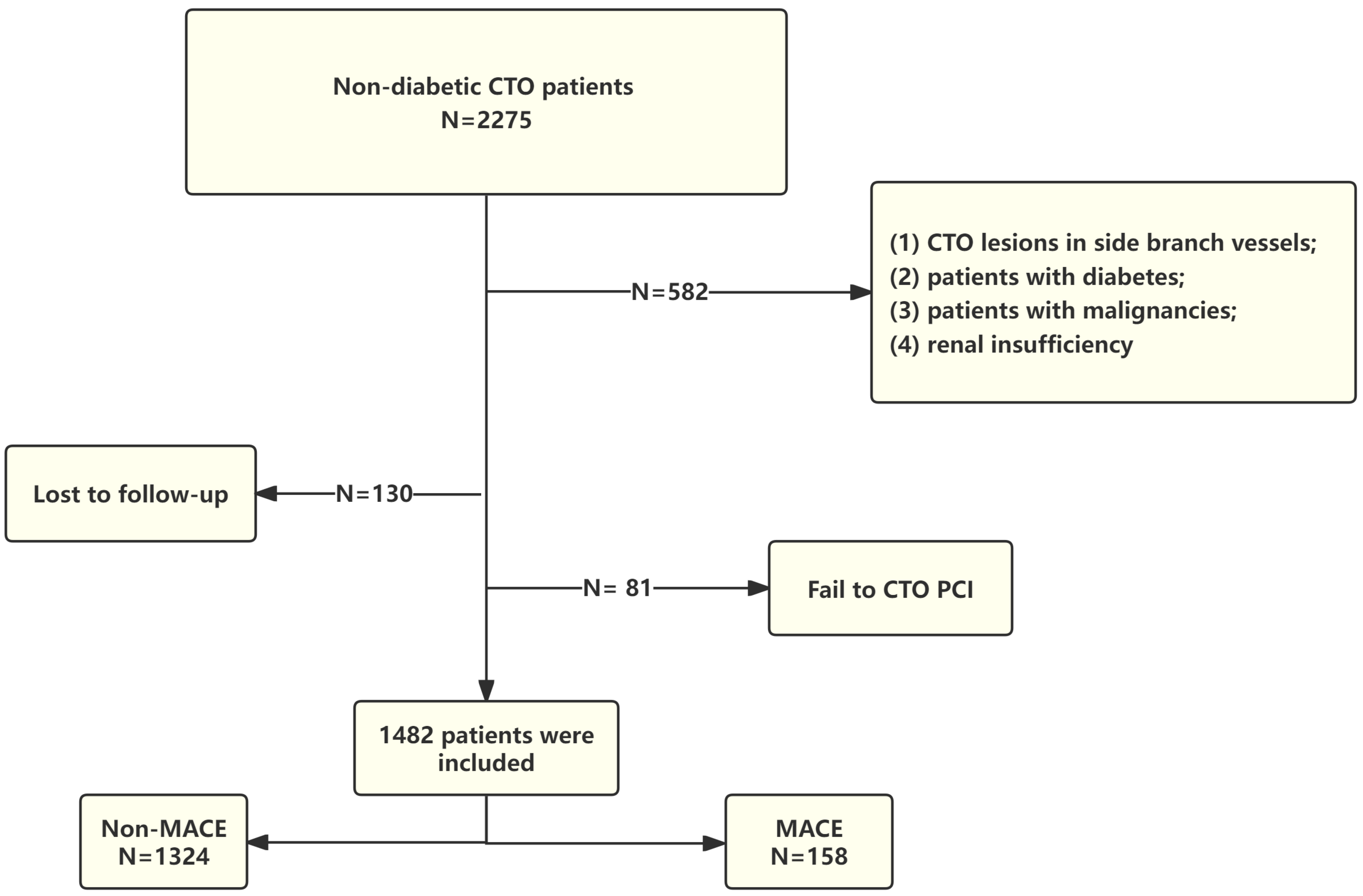
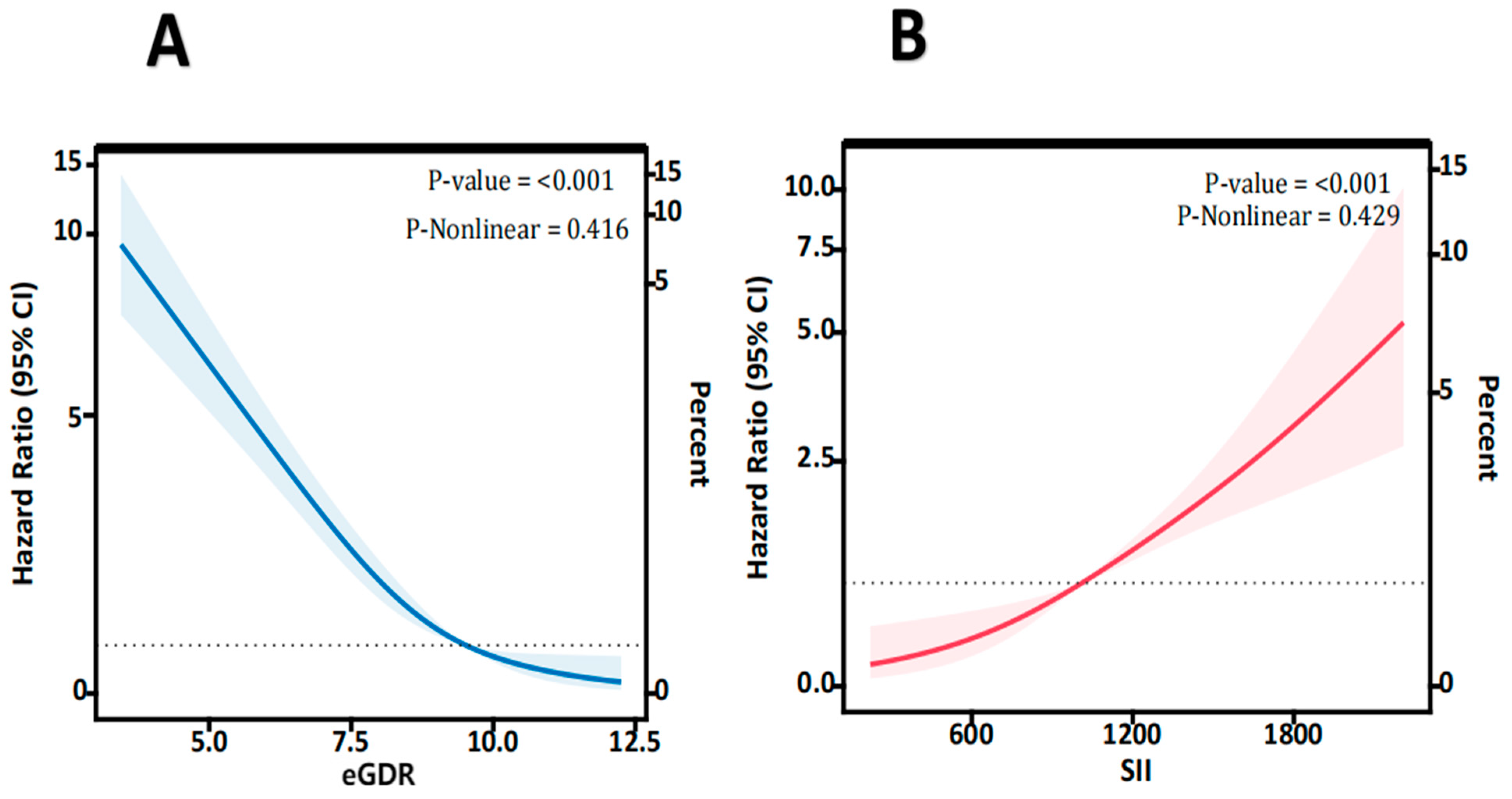
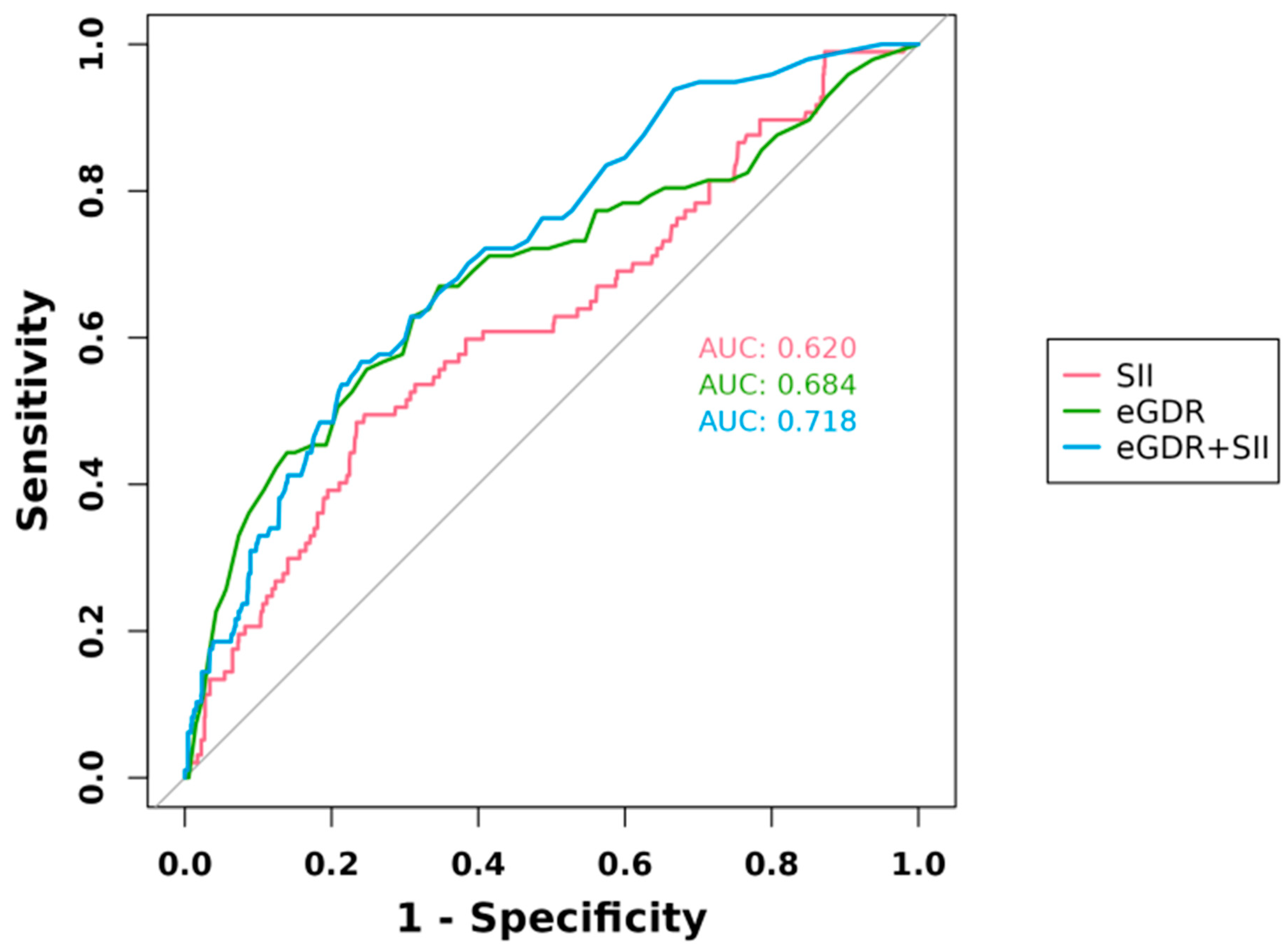
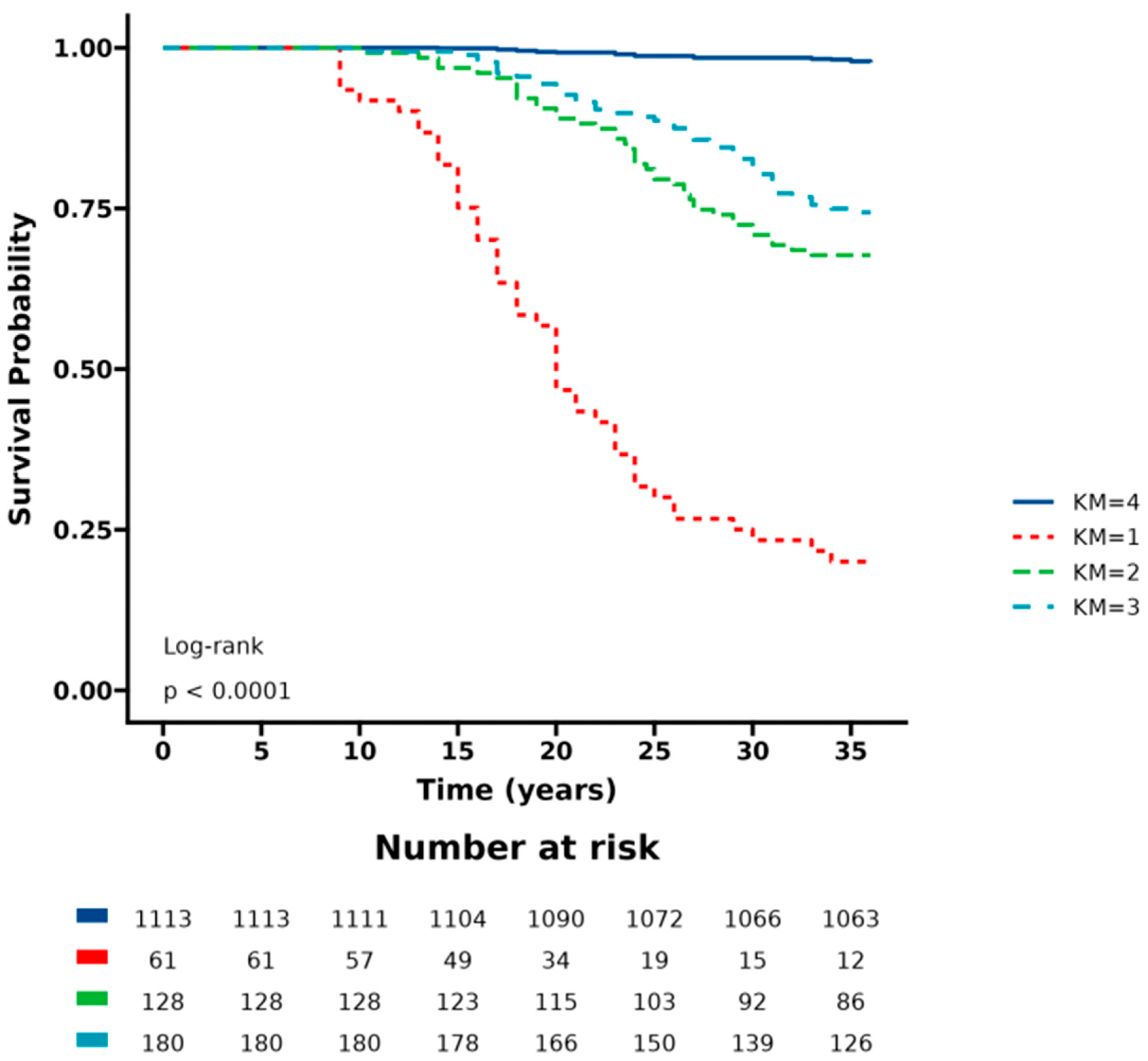
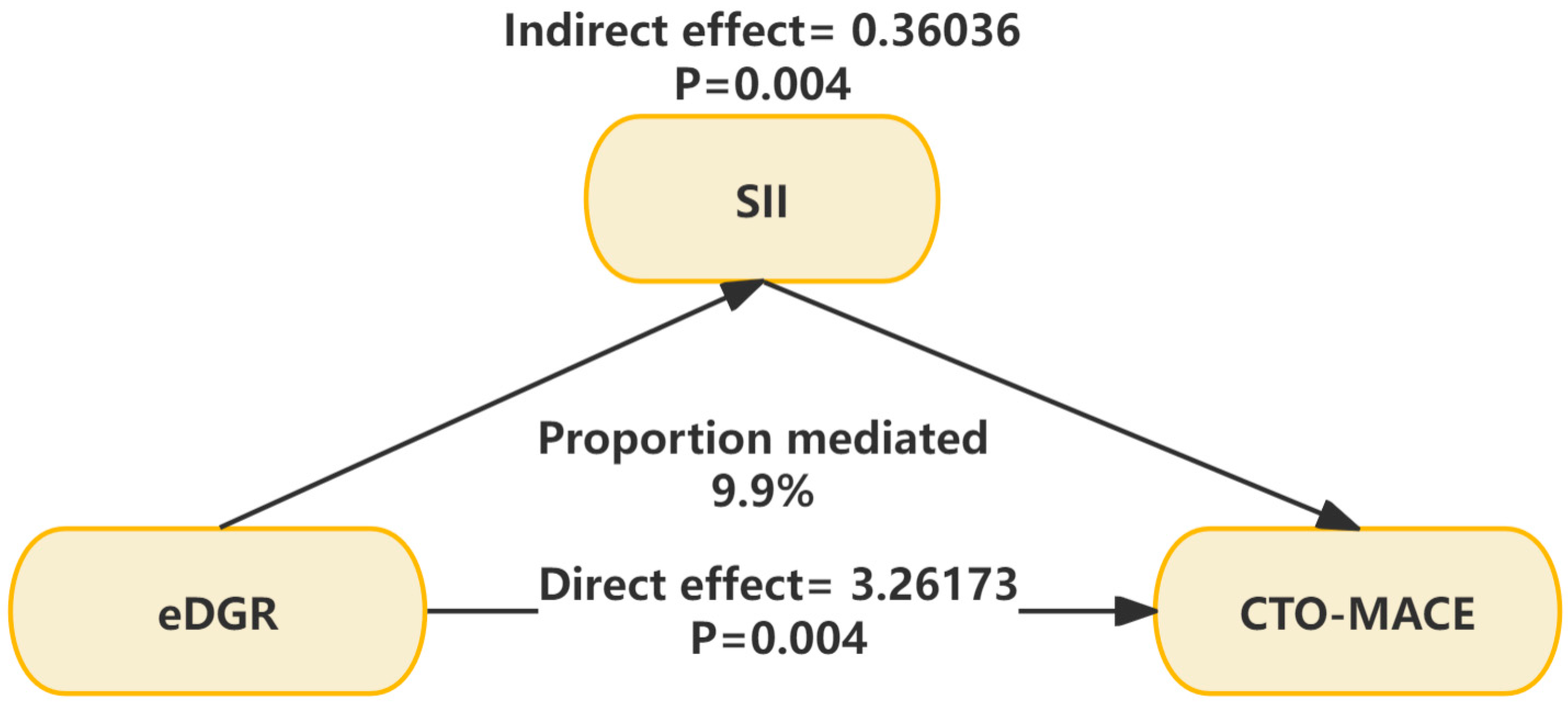
| Non-MACE (n = 1324) | MACE (n = 158) | p-Value | |
|---|---|---|---|
| Age, years | 59.9 ± 10.6 | 61.4 ± 10.7 | 0.442 |
| Male, n (%) | 1077 (81.4) | 129 (82.1) | 0.790 |
| BMI, kg/m2 | 27.4 ± 5.6 | 29.2 ± 6.8 | 0.021 |
| WC, cm | 90 ± 14 | 94 ± 15 | <0.001 |
| Smoking, n (%) | 442 (33.4) | 51 (32.2) | 0.340 |
| Hypertension, n (%) | 932 (70.41) | 120 (76.07) | 0.009 |
| Dyslipidemia, n (%) | 1116 (84.29) | 135 (85.40) | 0.844 |
| LVEF, % | 60.1 ± 7.4 | 54.7 ± 7.4 | 0.023 |
| Prior MI, n (%) | 392 (29.6) | 48 (30.5) | 0.124 |
| Prior revascularization, n (%) | 456 (34.42) | 51 (32.3) | 0.366 |
| Laboratory tests | |||
| Platelet, ×109/L | 235 ± 56 | 275 ± 75 | 0.001 |
| Lymphocyte, 103/µL | 2.04 ± 0.60 | 1.94 ± 0.73 | 0.124 |
| Neutrophils, 103/µL | 3.66 ± 1.34 | 5.21 ± 1.99 | <0.001 |
| HbA1c, % | 5.41 ± 0.48 | 5.55 ± 0.40 | <0.001 |
| FBG, mg/dL | 98 ± 18 | 101 ± 12 | <0.001 |
| TC, mg/dL | 195 ± 41 | 198 ± 40 | 0.177 |
| TG, mg/dL | 120 ± 97 | 130 ± 73 | 0.062 |
| LDL-C, mg/dL | 114 ± 36 | 119 ± 35 | 0.077 |
| HDL-C, mg/dL | 55 ± 16 | 52 ± 16 | 0.191 |
| eGDR (mg/kg/min) | 9.64 (8.55, 10.61) | 6.72 (5.02, 8.72) | <0.001 |
| Hs-CRP, mmol/L | 2.8 ± 3.3 | 3.4 ± 3.5 | 0.006 |
| SII | 409 (305, 562) | 810 (495, 986) | <0.001 |
| Intervention treatment, n (%) | |||
| LM | 25 (1.9) | 0 | 0.124 |
| LAD | 419 (31.7) | 55 (35.6) | 0.042 |
| LCX | 184 (13.9) | 22 (13.8) | 0.466 |
| RCA | 695 (52.5) | 81 (50.6) | 0.225 |
| Multivessel disease | 1162 (87.8) | 147 (93.5) | 0.051 |
| Complete revascularization | 1247 (84.23) | 125 (79.07) | 0.028 |
| Medication at discharge, n (%) | |||
| DAPT | 1322 (99.9) | 157 (99.4) | 0.580 |
| Antihypertensive | 864 (65.25) | 100 (63.29) | 0.209 |
| Statin | 1283 (96.9) | 152 (96.3) | 0.676 |
| Characteristic | Model 1 | Model 2 | Model 3 | ||||||
|---|---|---|---|---|---|---|---|---|---|
| HR | 95% CI | p-Value | HR | 95% CI | p-Value | HR | 95% CI | p-Value | |
| eGDR (continuous) | 0.47 | 0.42, 0.52 | <0.001 | 0.49 | 0.44, 0.55 | <0.001 | 0.55 | 0.51, 0.60 | <0.001 |
| eGDR | |||||||||
| Q1 (<8.08) | — | — | — | — | — | — | |||
| Q2 [8.08, 9.51) | 0.11 | 0.06, 0.18 | <0.001 | 0.13 | 0.07, 0.22 | <0.001 | 0.19 | 0.12, 0.30 | <0.001 |
| Q3 [9.51, 10.5) | 0.09 | 0.05, 0.15 | <0.001 | 0.11 | 0.06, 0.20 | <0.001 | 0.15 | 0.09, 0.25 | <0.001 |
| Q4 (≥10.5) | 0.02 | 0.01, 0.07 | <0.001 | 0.04 | 0.01, 0.10 | <0.001 | 0.06 | 0.03, 0.12 | <0.001 |
| SII (continuous) | 1.57 | 1.52, 1.72 | <0.001 | 1.59 | 1.54, 1.65 | <0.001 | 1.64 | 1.57, 1.70 | <0.001 |
| SII | |||||||||
| Q1 (<316) | — | — | — | — | — | — | |||
| Q2 [316, 431) | 1.39 | 0.72, 3.01 | 0.224 | 1.49 | 0.77, 3.18 | 0.211 | 1.53 | 0.81, 3.20 | 0.181 |
| Q3 [431, 597) | 2.18 | 0.87, 3.21 | 0.101 | 2.21 | 0.90, 3.24 | 0.092 | 2.31 | 0.95, 3.35 | 0.059 |
| Q4 (≥597) | 3.02 | 1.65, 5.52 | <0.001 | 3.20 | 1.72, 5.93 | <0.001 | 3.32 | 1.78, 6.33 | <0.001 |
| Characteristic | Model 1 | Model 2 | Model 3 | ||||||
|---|---|---|---|---|---|---|---|---|---|
| HR | 95% CI | p-Value | HR | 95% CI | p-Value | HR | 95% CI | p-Value | |
| High eGDR and low SII | - | - | - | - | - | - | - | - | - |
| Low eGDR and low SII | 1.27 | (0.78–2.01) | 0.211 | 1.31 | (0.82–2.16) | 0.171 | 1.54 | (0.94–2.14) | 0.103 |
| High eGDR and High SII | 1.03 | (0.54–1.57) | 0.501 | 1.07 | (0.63–1.77) | 0.371 | 1.39 | (0.76–2.01) | 0.229 |
| Low eGDR and High SII | 3.53 | (2.29–4.75) | <0.001 | 3.74 | (2.36–5.12) | <0.001 | 4.36 | (2.71–6.01) | <0.001 |
| Subgroup | eGDR | p for Interaction | SII | p for Interaction |
|---|---|---|---|---|
| HR 95% CI | HR 95% CI | |||
| Age (years) | 0.133 | 0.311 | ||
| <60 | 0.65 (0.55–0.76) | 1.92 (1.42–2.05) | ||
| ≥60 | 0.75 (0.65–0.87) | 0.081 | 2.17 (1.13–4.19) | |
| Sex | 0.523 | |||
| Male | 0.83 (0.75–0.93) | 2.31 (1.80–2.94) | ||
| Female | 0.70 (0.62–0.78) | 0.233 | 1.87 (1.57–2.05) | |
| LVEF | 0.801 | |||
| <35 | 0.89 (0.79–1.01) | 7.01 (1.90–12.56) | ||
| ≥35 | 0.82 (0.75–0.91) | 2.37 (1.37–5.08) | ||
| CTO | 0.647 | 0.497 | ||
| LAD | 0.90 (0.82–0.98) | 2.86 (1.45–4.54) | ||
| RCA | 0.66 (0.57–0.77) | 2.11 (1.38–3.00) | ||
| LCX | 0.71 (0.61–0.82) | 2.9 (1.01–4.56) | ||
| Complete revascularization | 0.079 | 0.569 | ||
| Yes | 0.71 (0.61–0.82) | 1.75 (1.01–3.08) | ||
| No | 0.91 (0.82–1.02) | 8.88 (5.28–14.75) |
| Independent Variable | Mediator | Total Effect | Indirect Effect | Direct Effect | Proportion Mediated, % (95% CI) | |||
|---|---|---|---|---|---|---|---|---|
| Coefficient (95% CI) | p-Value | Coefficient (95% CI) | p-Value | Coefficient (95% CI) | p-Value | |||
| eGDR | SII | 3.62209 (3.33176, 4.12312) | 0.004 | 0.36036 (0.25529, 0.65750) | 0.004 | 3.26173 (2.90567, 3.66547) | 0.004 | 9.9 (7.1, 17.3) |
Disclaimer/Publisher’s Note: The statements, opinions and data contained in all publications are solely those of the individual author(s) and contributor(s) and not of MDPI and/or the editor(s). MDPI and/or the editor(s) disclaim responsibility for any injury to people or property resulting from any ideas, methods, instructions or products referred to in the content. |
© 2024 by the authors. Licensee MDPI, Basel, Switzerland. This article is an open access article distributed under the terms and conditions of the Creative Commons Attribution (CC BY) license (https://creativecommons.org/licenses/by/4.0/).
Share and Cite
Chen, W.; Liu, Y.; Shi, Y.; Liu, J. Prognostic Value of Estimated Glucose Disposal Rate and Systemic Immune-Inflammation Index in Non-Diabetic Patients Undergoing PCI for Chronic Total Occlusion. J. Cardiovasc. Dev. Dis. 2024, 11, 261. https://doi.org/10.3390/jcdd11090261
Chen W, Liu Y, Shi Y, Liu J. Prognostic Value of Estimated Glucose Disposal Rate and Systemic Immune-Inflammation Index in Non-Diabetic Patients Undergoing PCI for Chronic Total Occlusion. Journal of Cardiovascular Development and Disease. 2024; 11(9):261. https://doi.org/10.3390/jcdd11090261
Chicago/Turabian StyleChen, Wenjie, Yiming Liu, Yuchen Shi, and Jinghua Liu. 2024. "Prognostic Value of Estimated Glucose Disposal Rate and Systemic Immune-Inflammation Index in Non-Diabetic Patients Undergoing PCI for Chronic Total Occlusion" Journal of Cardiovascular Development and Disease 11, no. 9: 261. https://doi.org/10.3390/jcdd11090261




